AMD Socket-AM2: Same Performance, Faster Memory, Lower Power
by Anand Lal Shimpi on May 23, 2006 12:14 PM EST- Posted in
- CPUs
A New FX
The next new CPU introduction that we're here to evaluate is the Athlon 64 FX-62, a 2.8GHz dual-core FX part that's debuting exclusively on the Socket-AM2 platform. Given AMD's policy of only having one active FX part at a time (prior violations of this rule aside), the FX-62 is the only FX on the AM2 platform. The FX-60 still reigns supreme on the Socket-939 platform, and since the two platforms perform the same we can pretty much compare the FX-60 to the FX-62 directly without worrying about any motherboard/memory/chipset differences skewing the comparison. Of course no very-high-end CPU comparison is complete without Intel's latest Extreme Edition processor, which in this case is the Pentium Extreme Edition 965 we reviewed back in March.
3D Rendering - Cinebench 9.5
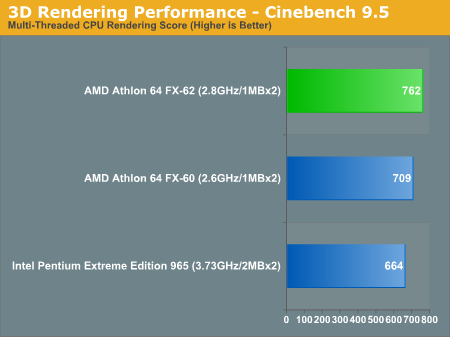
The beauty of the FX series of AMD processors is that its cache size doesn't vary like the rest of the Athlon 64 line, so the FX-62 has an undeniable performance advantage thanks to its 2.8GHz clock speed. The clock speed advantage is able to give it a pretty decent performance boost over the FX-60 here, as well as over the Pentium EE 965.
3D Rendering - 3dsmax 7
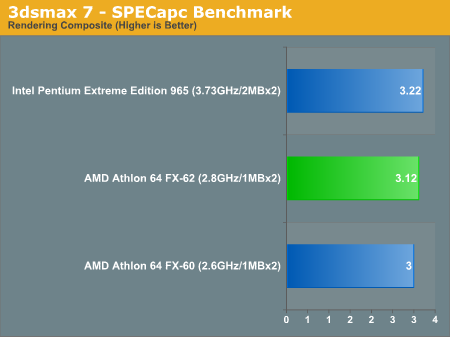
While we see a performance increase over the FX-60 in 3dsmax 7, it isn't enough to catch up to the performance of the Pentium EE 965. At 3.73GHz, the 965 is an extremely formidable competitor and very high performance CPU for 3dsmax rendering tasks.
Video Encoding - DivX 6.1.1 Pro

Intel gets the slight nod in DivX encoding performance, with the FX-62 falling smack in the middle of the chart here between the 965 and the FX-60.
Video Encoding - Windows Media Encoder 9
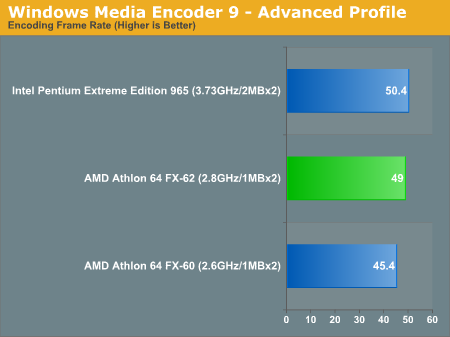
The situation doesn't really change with WME9; the FX-62 manages to come very close to the Extreme Edition 965's performance but falls a little short. The improvement over the FX-60 is quite noticeable here.
Video Encoding - Quicktime 7.0.4 (H.264)
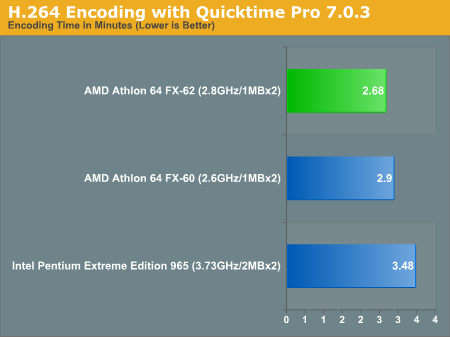
Apple's Quicktime for Windows has never run well on Intel processors, and the FX-62 takes good advantage of that fact by putting the Extreme Edition 965 to shame in our H.264 encoding test. After looking at the 4000+ vs. 3800+ comparison on the previous page, it's nice to see a real tangible performance difference between two AMD CPUs.
MP3 Encoding - iTunes 6.0.1.4
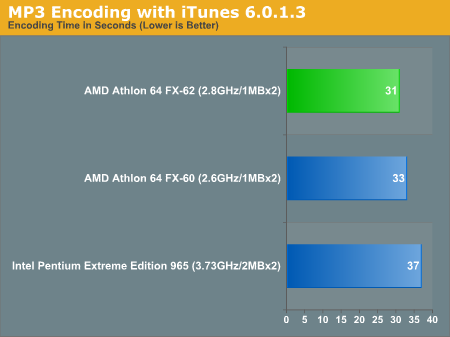
While all three CPUs are very competitive in their MP3 encoding performance the Athlon 64 FX-62 is the clear winner here, finishing the encoding task 16% faster than the Pentium EE 965.
Gaming - Quake 4
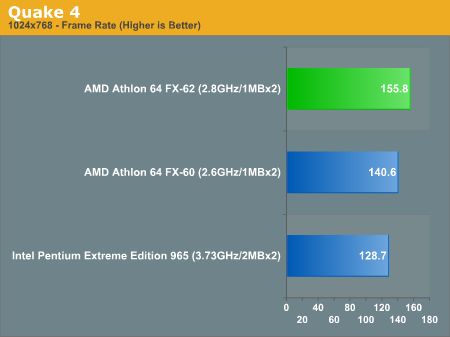
At higher clock speeds the Athlon 64 FX-62 really separates itself from the Pentium EE 965, offering a very significant 21% performance advantage in Quake 4.
Gaming - F.E.A.R.
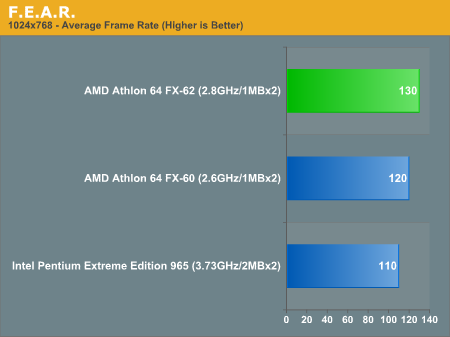
The AMD gaming advantage continues in F.E.A.R., this time the FX-62 holds on to a solid 18% lead.
Gaming - Oblivion
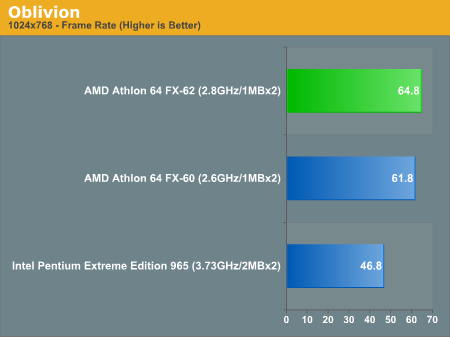
The Pentium Extreme Edition 965 is utterly disappointing in Oblivion, as the FX-62 outperforms it by an incredible 38%. With a very CPU and GPU dependent game like Oblivion, you can't ignore these types of performance differences, especially if you plan on feeding a pair of high end GPUs in SLI or CrossFire.
Athlon 64 FX-62 Conclusion
The Athlon 64 FX-62 verdict is a lot easier than with the 4000+ since the performance advantage is clear thanks to a 1MB L2 cache per core and an increase in clock speed. We would still recommend the FX-62 over the Extreme Edition 965 for gamers, but as we've seen in the past there are some situations where being able to execute four simultaneous threads, as you can with the EE, has its benefits.
Given the incredible price premium you pay for the FX-62, we would still strongly recommend going with a lower clocked Athlon 64 X2 instead. You can always overclock to get close to FX-62 performance or, alternatively, you could stay at the lower clock speed and enjoy lower thermal output.










83 Comments
View All Comments
mlittl3 - Tuesday, May 23, 2006 - link
Until K8L (which will have microarchitectural improvements), there are a few things that could allow AMD to look good against Core 2.1) Price drops so that comparable K8 and Core 2 processors are the same price giving the same performance/$ ratio (this metric is important for the budget constrained)
2) Nov. '06 release of 65 nm AM2 processors so that K8 and Core 2 processors will have the same performance/watt ratio (65 nm could give K8 a 20% drop in power and with Core 2 being 20% faster, they will have the same performance/watt ratio which is popular now). Also, everytime AMD transitions to a new die process they add some minor bug fixes and minor memory/microarchitectural enhancements which could also boost performance by a few percent.
3) Continual improvements to DDR2 latency might yield a 2-2-2 DDR2 800 memory module which will probably benefit K8 more (maybe ~5% improvement) than Core 2 but this is a wild guess here and I don't know if it is even possible. However, DDR400 latency started around 4-4-4 and dropped to 2-2-2 so it could happen.
With the same performance/price and performance/watt as Core 2, K8 could stay competitive and OEMS and users decide on which company (if not both) they would like to do business with. This is all speculation and of course everyone is more than welcome to rip my reasoning to death.
JarredWalton - Tuesday, May 23, 2006 - link
I seriously doubt we will ever see DDR2-800 running at 2-2-2 timings. (Feel free to quote me on this in the future and make fun of me if I'm proven wrong. :-)) Just think how long we had DDR memory around, and no one ever managed to create 1-1-1 DDR-400 memory. I do think we will see 3-3-3 DDR2-800, and possibly even higher bandwidth with those timings. In fact, we almost have that already judging from my experiences so far with socket AM2. (I can post and run benchmarks, but I wouldn't call the system 100% stable.)mlittl3 - Tuesday, May 23, 2006 - link
LOL! I will!MacGuffin - Tuesday, May 23, 2006 - link
From Patriot's PDC22G8000+XBLK Rev. 2 review on PCSTATS.Rated for DDR2-667 @ 3-3-3-9 (Maintains those timings through DDR2-940!)
Rated for DDR2-1000 @ 4-4-4-12 (Goes Up to DDR2-1020!)
Completely stable on the Intel platform they used. It's extremely expensive (saw it for $400+ at NewEgg). But yes, it is possible to run 2GB at these timings already. Its just extremely expensive.
EdisonStarfire - Tuesday, May 23, 2006 - link
any opinions on AMD offering a Clearspeed solution as stop-gap in the high end desktop arena ?Griswold - Tuesday, May 23, 2006 - link
The bottom line is, we now know what we knew last fall, or rather (rightfully) assumed.Now you made me curious. Could that be the "noise in june" which Henri Richards mentioned in a Register interview earlier this month?
smn198 - Wednesday, May 24, 2006 - link
It is called quad-core.temp2 - Tuesday, May 23, 2006 - link
The extremetech.com article has a similar teaser at the end, but it is slightly more specific:
"And given recent discussions with AMD, we can safely say that the company hasn't launched its last FX series CPU for the year quite yet."
mino - Wednesday, May 24, 2006 - link
This provided, 3.2 or even 3.4 FX's on 65nm are on the way...Scrogneugneu - Tuesday, May 23, 2006 - link
Beware the mighty Sempron FX 32 !